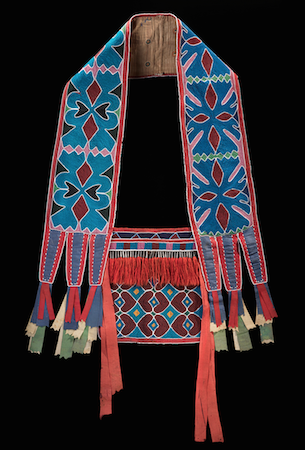Lenape (Delaware tribe, Eastern Woodlands). c. 1850 C.E. Beadwork on leather
This is an object that invites close looking to fully appreciate the process by which colorful beads animate the bag, making a dazzling object and showcasing remarkable technical skill.
Complete Identification:
Bandolier bag
no known artist
1850 C.E.
Beadwork on leather
Lenape people
Delaware tribe, Eastern Woodland
Form:
Bandolier and bag are connected
Bandolier
Red trimming around entire cloth and tassels at the end
Floral blue, black, green, and pink pattern on cloth
Ends of the bandolier have trapezoidal extensions which end in green, red, tan, and blue tassels
The bandolier is a long rectangle, would reach below the waist (but likely not to the knees)
Only one side of the bandolier is decorated → the other side is brown
Bag
Follows same color story as bandolier → shares the pink, blue, and red
Tassels decorate the opening of the bag (shorter and thinner than the tassels on the bandolier)
Rectangular in shape
Function:
Bandolier bag is worn as a cross-body bag → a strap crosses the chest and allows the bag to rest on the hip
Bags were commonly decorative → even those with pockets were not necessarily used to hold anything
Men could wear more than one bag at a time
Express group identities and social status
Especially in the face of displacement → represent the determination and perseverance of Lenape people and Lenape culture
Content:
There are thousands of beads strung together across the bandolier bag’s surface
Show mastery of technical skill
Based on bags carried by European soldiers that held ammunition for rifles
Large in size
Trade cloth (cotton, wool) and hide are used as the base for the bags and straps
Seed beads (tiny glass beads) are acquired from trading with Europeans
Prized for color
Replaced porcupine quills as base for colors in the bags
Porcupine quills would be dyed and woven into the cloth
Silk ribbons are also used for decoration → gained from trading as well
Expanded the surface of the bag in an interesting way
Trading with the Europeans allowed for new materials to be added as decoration to the bags
Replaced further quillwork and dying of the bandolier’s fabric
Beads would reflect sunlight, ribbons would flap in the wind
Red wool tassels on the bag are attached with metal cones → add more colors and textures
Designs
Abstracted and asymmetrical
White beads act as contour lines
Each side is slightly different in design
Small size of the beads allows for more intricate designs than quillwork
Contrasting colors could represent Sky and Underworld realms
Design could also represent cardinal directions, as they go in four different directions
Context:
Called Aazhooningwa'on in Ojibwe language (“worn across the shoulder”)
Made across tribes in Great Lakes and Prairie regions
Styles depend on tribe and on contact with Europeans (for materials)
Bandolier bags especially popular in Woodlands region (Great Lakes and territory East of Mississippi) in nineteenth century
Women created the bags, while mostly men wore them
Prairie style
Incorporates styles from older Delaware traditions as well as other displaced native peoples
Result of different peoples coming together
Used glass beads to make abstract or representative floral patterns against a dark background
Bandolier bags still worn today → show preservation of culture
Lenape
Originally from Delaware → the Eastern woodlands
Some lived in large villages but most lived in smaller communities of up to 25 people
Had three clans (Wolf, Turtle, Turkey) that traced lineage through mother’s ancestry
Very communal → land belonged to community, shared shelters, no theft
Political leaders were chosen based on leadership characteristics and ability to lead successfully
War leaders were chosen based on success in battle
They could act without the approval of the political leader
Men
Woodcraft and hunting, cleared the land, built/repaired houses
Women
Housekeeping, gardening, planting and harvesting crops
Making clay pots; weaving; making slippers, mats and dolls; preparing hides for clothes and shelters
Were removed from their ancestral lands by Indian Removal Act (during Jackson’s presidency) but kept their traditions in creating art
Bandolier bags are an example of the perseverance of their culture
Religion was animistic → spirits (both helpful and harmful) were everywhere and should be treated with respect
Ceremonies throughout year to drive off evil spirits and celebrate good ones
Celebrations of maple tree and corn planting, harvest rituals
Shamans were important spiritual leaders (sometimes political too)
Themes:
Materials and symbolism
Relationship with nature
Colonialism
Effects on culture
Effects on art
Lasting effects of displacement and cultural diffusion/dispersement
Cross-Cultural Connections:
Reflects the importance of textiles as an individual art form in the Americas (especially in Inca culture)
Textiles are not used to imitate other art forms
In fact, other art forms often imitate textiles
Textiles are a complex and technically challenging art form, which shows the mastery of the indigenous peoples over this form
Sources:
https://www.khanacademy.org/humanities/ap-art-history/indigenous-americas/a/bandolier-bag
https://www.lenapelifeways.org/lenape1.htm

